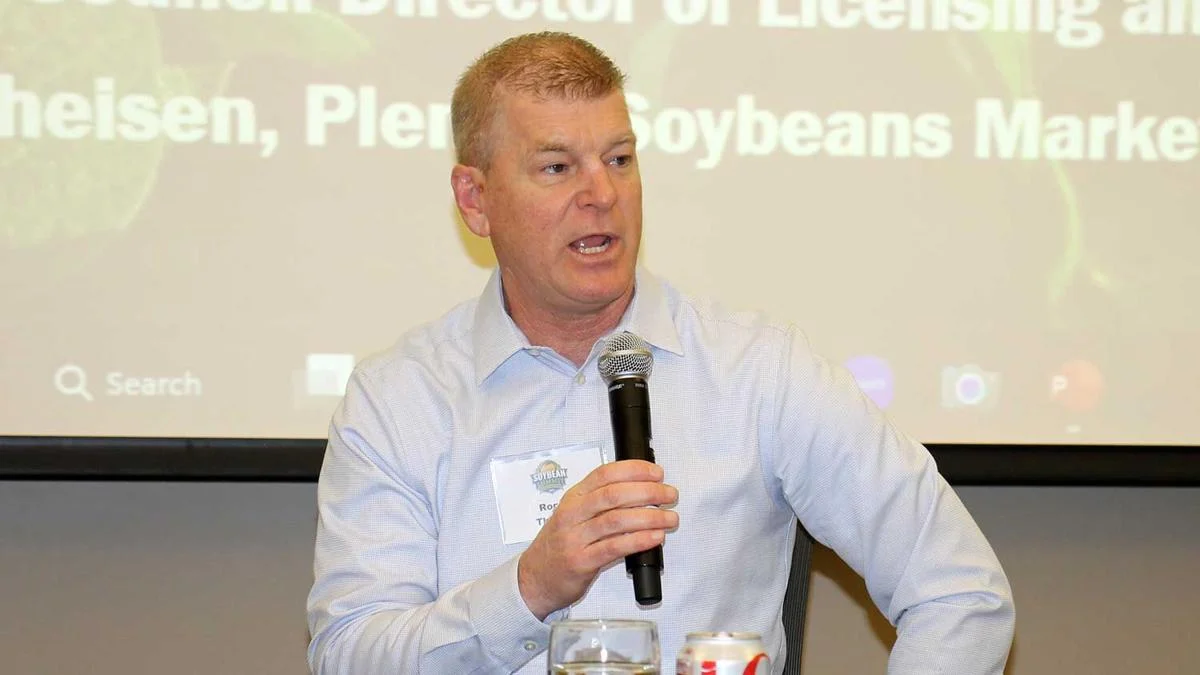
Photo by Phyllis Coulter.
CHAMPAIGN, Ill. — At a time when input costs are higher, soybean growers may consider if growing a crop with a higher premium might help improve the bottom line. They had the opportunity to consider a few options at the Illinois Soybean Summit in Champaign Feb. 2 when a panel of experts discussed specialty soybeans.
Such specialty crops have their identity preserved from the time they are conceived until they meet their end by going into processing, explains Bryan Stobaugh, director of licensing and commercialization for the Missouri Soybean Association. For that effort, which may include specialized storage and transportation, growers receive a premium.
Jeff Johnson of Benson Seeds, a vertically integrated system, explains that growers earn their premiums by raising Benson Hill soybeans for specific processing which may be for fish feed or specialty foods. He gives the example of “ultra-high protein” soybeans sold to ADM with a $7 premium per bushel or early-maturing non-GMO soybeans for fish food in the aqua industry which offers a premium of $5/bu.
Another specific market attracting growers is high oleic soybeans. Roger Theisen, Plenish Soybeans marketing manager for Pioneer, said this product gives soybean growers hope to win back some of the buyers they lost when concerns about trans-fat came to light. The aim to also to find processing in the best geographical areas to fill downstream demand.
Research on high oleic oil is showing the market benefits of healthier oil “so we can capture back some of the oil acres we lost in the trans-oil period,” he said. “It’s great not to rely so much on export markets.”
Stobaugh said organic and non-GMO products for example appeal to the social shopper.
“I’m a farm child. I’ve got to feed somebody,” said Stobaugh, who grew up in Missouri in an area where rice was grown. Specific crops will be grown in specific areas to meet special markets, he said of future trends.
To earn the premiums, growers may have to do something different, which may mean investing in specific equipment or storage for the product, Theisen said. Growers of Plenish do get assistance with seed selection and information on the latest agronomy research both from pioneer and other researchers, Theisen said.
Today, soybeans are no longer seen as a rotational crop for corn. Thankfully there are good prices and maximum yields today with more markets coming. In the 1980s, about half of the U.S. soybeans were going to China, Johnson said.
Farmers have always been innovative and tight managers. Soybean checkoffs are leading the way in research to help growers address the mindset of consumers, said Stobaugh.
Growers had questions about what to expect including yield drag for specialty beans.
“Sometimes there is no yield change,” Johnson said. Other times in high protein soybeans there may be 10 to 13%.
“Our premiums more than make up for that,” he said.
One grower spoke up about waiting 5-6 hours to unload high-protein soybeans at ADM.
“With that delivery experience, it’s not viable,” the farmer said.
Johnson said that concern is being addressed and this year loads will be scheduled at ADM in Decatur, Illinois for example so the wait is more manageable.
The panel of experts, including moderator Kellee James, founder and CEO of Mercaris, a company that provides market data and online trading for identity-preserved ag commodities, all see demand for specialty crops to continue to grow.
Oil companies are investing in soybean-crushing plants. Auto manufacturers like Ford Motor Company, are looking at soybeans for their potential as renewable diesel sources. On the food side, the oleic oil lasts longer than other types of oil and it helps save time when there is a labor shortage in restaurants and food service, Theisen said.
With the world’s increase in demand for protein, Johnson said there will continue to be demand for feed for the growing aqua industry, for example.
Boots on the ground, including from Extension, state soybean associations, independent agronomists, researchers, and others are helping farmers as they strive to be productive, carry their margins and explore forms of regenerative agriculture, Theisen said.
As an industry, soybeans are working on those goals developing more tools to make it possible, said Theisen, who has been in the seed and crop protection business for more than 25 years.
“There is a lot of great potential,” he said.
